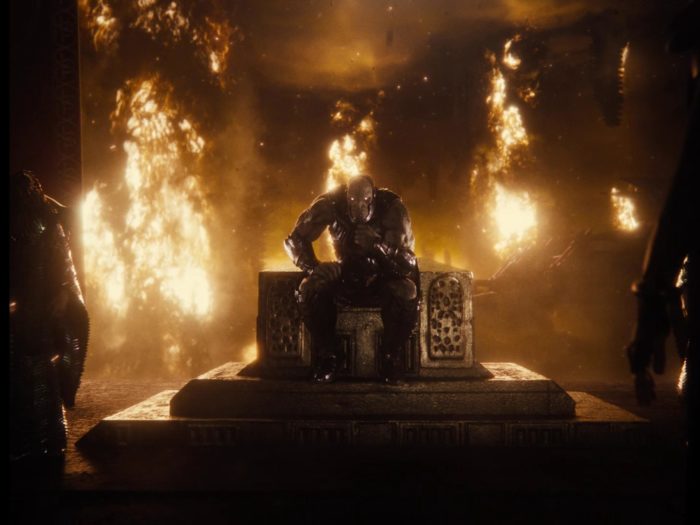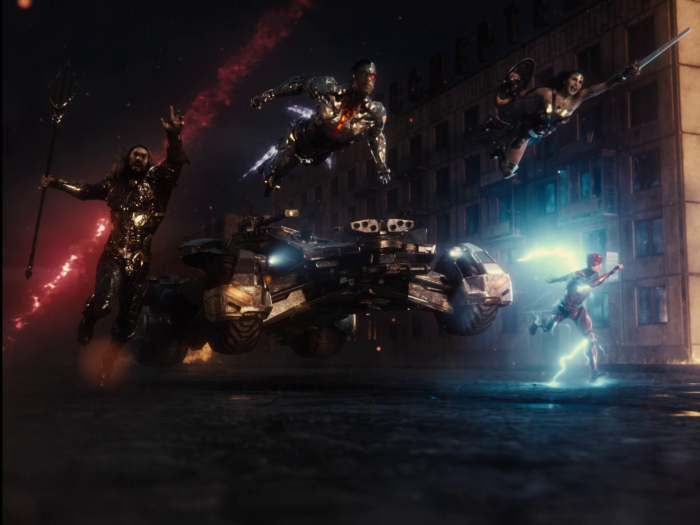
We gave up a lot of things in 2020 and that sucked. One thing that maybe actually needed a break was the superhero genre, which has dominated cinemas for more than a decade now. Last year, only DC managed to release anything (Birds of Prey and WW84) unless you count the final season of Marvel’s Agents of SHIELD, which was probably only watched by me. Well, now it’s 2021 and we’re coming back and we’re all super depressed. Over the next few… however long this takes me, I’m going to review all the sad new superhero shows and movies of 2021 leading up to Black Widow‘s release in July. Come wallow with me!
I’m thankful that I’ve had enough time for a whole other Zack Snyder streaming movie to come out before writing about Zack Snyder’s Justice League. Because I still haven’t quite figured out how to feel about this “movie.” And I have to admit, in and of itself, that is a failing of my personality. I’d much rather be the kind of guy who never thinks about Justice League at all. Not just because I’m an adult man in my thirties and this is a movie about superheroes beating up demons – sorry parademons – but also for what this release represents. The Snyder Cut is just as much a victory for passionate fandom over bad corporate decision-making as it is another alarming sign about the toxic power of butthurt nerds on the Internet (RIP The Rise of Skywalker, another Chris Terrio joint).
By all accounts, the Snyder Cut exists not because “it was already completed and sitting in Warner Bros’ vault” but because HBO Max “the worst streaming service” has different management than the studio. The streaming folks were looking for an easy win and giving $70 million to Zack Snyder’s populist movement probably seemed relatively cheap compared to the big exclusivity deals Netflix, Hulu, and the rest of the industry were making. That gamble almost immediately paid off in publicity alone, especially when the pandemic shut everyone down and Justice League was able to keep numerous artists working on visual effects, editing, a new score, and more over the last year. They even brought back the cast for some pickups, although I’m still not exactly sure how much new footage was actually required.
It’s stuff like that they make me want to like this super-sized film more than I do. Snyder seems like a genuinely good dude who inspires loyalty in the people who work for him, an unfortunate rarity in cinema these days. What happened to him during the production of Justice League was tragic. The way the studio capitalized on that as a way to seize creative control is disgusting. And frankly, Joss Whedon’s star couldn’t have fallen any farther than it already did, so no one’s going to defend that fraud. All that said, there is just a fundamental disconnect between the types of superhero stories I’m interested in and those that Snyder wants to tell.
One thing Dawn of Justice made clear is that in the Snyderverse, being a superhero is a curse that pushes you away from the people you should want to protect. Every single member of the Justice League has daddy issues. Superman saving people is treated like the worst thing that’s ever happened to the planet. Years of crime fighting have turned Batman into a ruthless killer. The others all believe themselves to be outcasts who need to hide their existence. Both versions of Justice League try to lighten this extremely dark picture, but not nearly enough for me. If superheroes aren’t inspirational (or at least fun) then what’s the point of telling such a fantastical story? Why not just make crime dramas or disaster films?
Anyway, this version of the Justice League begins with Superman’s death during the final battle of Dawn of Justice. As he is impaled, the Man of Steel lets out a mighty yell that shakes the planet and awakens the “Mother Boxes,” three objects that attract the (now very spiky) alien Steppenwolf, who wants to gather them so he can terraform the planet. And this leads into another one of my biggest pet peeves about the DCEU: the repetition. We already saw a terraforming plot in Man of Steel. We already saw Wonder Woman learn to be part of a team. We already saw Batman learn not to give into his darkest impulses. There are other stories to tell with these iconic characters!
What’s most frustrating is Snyder’s obsession with making Superman bad. Man of Steel had evil Kryptonians and Dawn of Justice made a lot of characters think The Last Son of Krypton had to be stopped, but Justice League also has to include a scene where the team fights a deranged Superman. What’s worse, The Snyder Cut ends on a cliffhanger of a potential future where Superman has turned bad and allied himself with Darkseid. Hey, you dingus, the whole reason making Superman a villain is interesting is because he’s supposed to be the most good person in the world. That’s really not the case if he spends more time being evil (or bizarrely distant) than good. Seriously, these movie are like if J. Jonah Jameson was allowed to write Spider-Man stories.
The great tragedy of the theatrical – and therefore the biggest blessing of the Snyder Cut – is that the boring returning character stories get in the way of the superior arcs the new members of the team have. Aquaman’s (Jason Mamoa) conflict as a child of two worlds (much like Superman and Wonder Woman) is given enough room to make sense, instead of being brushed aside to make him the ultimate bro. The Flash’s (Ezra Miller) struggle to balance his attempts at becoming a superhero with his real life obligations make more sense, and this version’s portrayal of super speed as a power is maybe the best I’ve seen in a movie. But the best story in the whole movie is Cyborg’s.
Justice League was a clusterfuck that left a bitter taste in the mouths of seemingly everyone who worked on it, but Ray Fisher got it the worst. Fisher has been open about the abusive behavior of Joss Whedon and Walter Hamada that likely correlated with Cyborg’s minor role in the theatrical cut of the film. They’re also the reason he won’t be appear in the Flash sequel that supposedly coming out next year. But in the Snyder Cut, Cyborg nearly takes center stage, as we get to follow his arc from promising college athlete to a mechanical man in great detail. He even gets the only moment superpower-related joy in the entire movie, when he uses his powers to overload an ATM and give a needy mom a break. If all this footage existed and Whedon didn’t want to include it in the movie, it’s a pretty damning indictment of his character.
It seems everything about this fuckin’ movie has to be long-winded, so I’ll summarize. Despite my disinterest in “dark” superhero stories, Zack Snyder’s Justice League is definitely a lot better than the previous theatrical cut. I’d go as far as to say that it’s good. It’s also extremely pretentious, which you’ll notice immediately when you hit play and are told that you’re about to watch a movie made in 2021 that’s “presented in a 4:3 format to preserve the integrity of Zack Snyder’s creative vision.” Which is code for it was shot for IMAX, could be cropped to fit a wider ratio easily enough, but instead you’ll get to watch a version with a lot of extra head room.
Not that it’s a total visual downgrade, a lot of the VFX shots have been touched up and look a ton better. Most notably, Cyborg and Steppenwolf, who both looked ridiculous last time around, look great in this (if needlessly complex). Zack Snyder has an amazing sense of composition and there are plenty of (arguably too many) gorgeous moments to feast upon with your eyes. Compared to Joss Whedon’s ironically more television-influenced shooting style, Snyder seems like an outright master. The darker, less saturated look of the Snyder Cut is clearly what the costumes and lighting were designed for, so that’s a win here too. Really my only technical complaint is that we didn’t need so much slo-mo in a four hour movie.
And that’s the biggest reason that I still won’t recommend Justice League: it’s four damn hours long! Snyder over-corrected and added back in scenes that should definitely be cut, including more than half an hour of setup for a sequel that surely will never be made. He adds in scenes that are overly long, scenes that are repetitive, and scenes that leave dangling threads that are never resolved. I had to watch it in three separate sittings over two days. If you have the interest and the patience for that, you already watched this back in March. For everyone else, well, at least we can use that HBO Max subscription to keep up with Hacks.



